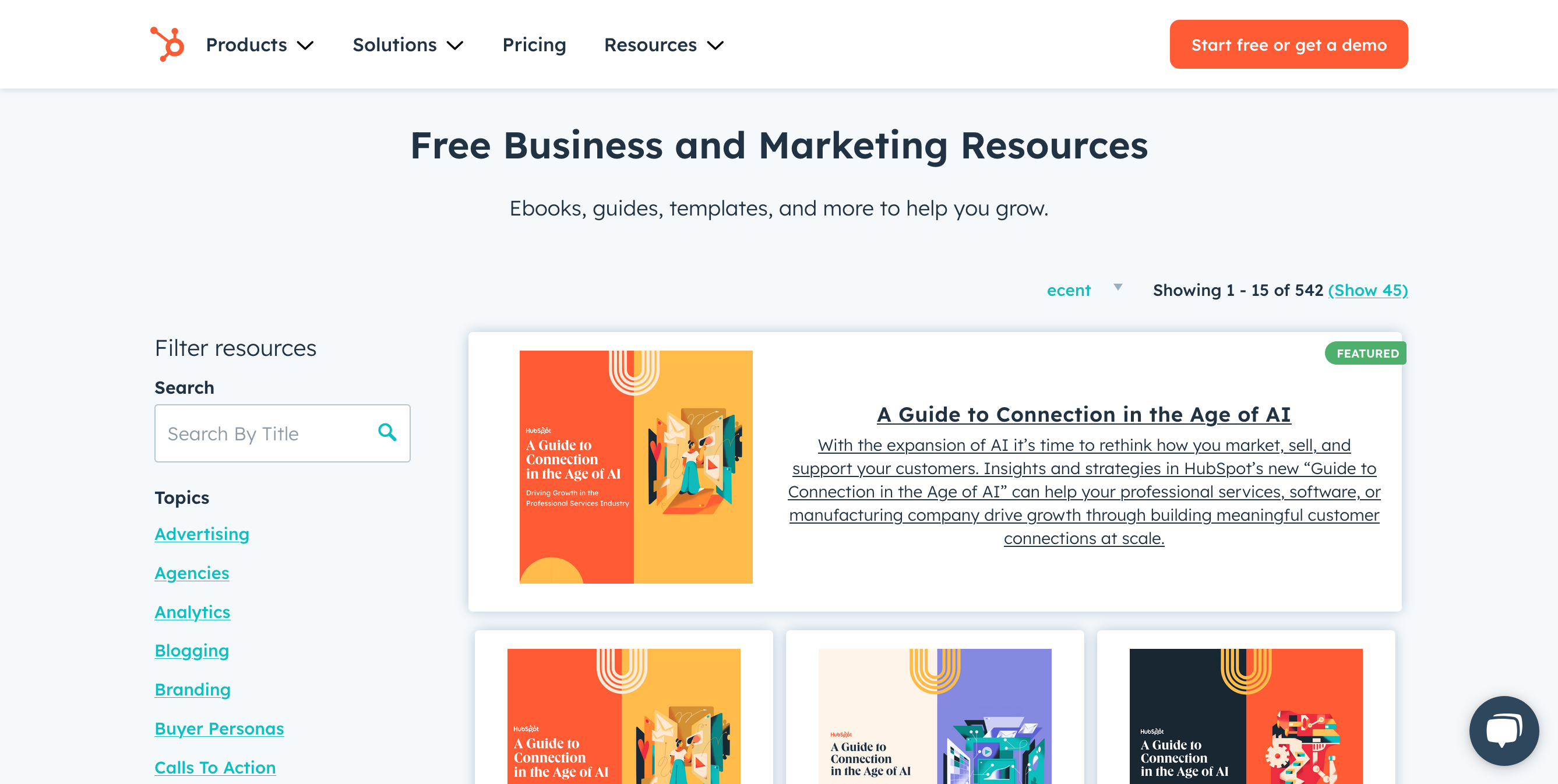
How to Build a Content Hub Step-by-Step


A content hub is a centralized digital platform that serves as a comprehensive repository of knowledge and information on a specific topic or industry.
Its primary purpose is to educate, inform, and engage users rather than directly sell products or services.
Content hubs typically feature a variety of media types, such as articles, videos, infographics, and podcasts, organized in a user-friendly manner.
Content hubs take many shapes and sizes, with some being primarily video-based, others being very broad (like Wikipedia, for example), and others still being primarily focused on a very narrow part of a particular industry.
One thing's for sure, the best brands on the planet -- brands like Investopedia, Hubspot, NerdWallet, Salesforce and more -- invest heavily in their content hubs, and for good reason.
In this blog post, we'll go over the immense benefits of building out your content hub, but also the practical nuts and bolts of how to do it, down to the details.
Let's get started.
Key Takeaways:
The content hub is a powerful marketing tool that attracts, educates, and entertains your target audience. It's essential for building trust and demonstrating the value of your business.
A relevant content hub provides detailed information that can be easily accessed in one place. All forms of content should work together to provide an enriching experience for readers.
Digital marketers make it easier to update or maintain a content hub. Rightpoint provides content and creative services to ensure your website is rich with high-ranking and relevant content.
Why are Content Hubs Important in Digital Marketing?
It's no secret that the world turns to the internet to learn things. Just go to Google and type in, "how to..." and see what pops up in the search suggestions.
Brands quickly realized (sometime in the late 2000s when content marketing became a thing), that if they could be a part of this "learning" conversation, they would win more business.
In fact, if they could produce the content that people learned from, they'd not only win more business, but be seen as an authority in their vertical.
When you go to Investopedia and you see the tens of thousands of knowledge articles about investing and the stock market, you trust them more, and are therefore more likely to click one of their affiliate links.
When you see the immense catalog of learning materials on Salesforce's Trailhead content hub, you feel empowered to continue using their software.
Here are some other benefits to building and growing a content hub:
1. Improved User Experience: By organizing related content in one place, you make it easier for users to find what they're looking for, increasing engagement and time spent on your site.
2. Enhanced Search Engine Optimization (SEO) Performance: Content hubs can significantly boost your search engine rankings by creating a web of interlinked, relevant content around specific topics. They also help you capture traffic from non-commercial search terms, which often have much higher monthly search volume.
3. Establishment of Thought Leadership: A comprehensive content hub demonstrates your expertise in your field, helping to position your brand as a thought leader.
4. Increased Content Discoverability: With a well-structured hub, users are more likely to discover additional relevant content, increasing page views and reducing bounce rates.
Understanding Content Hubs
Before we dive into the how-to, let's explore the various forms content hubs can take and look at some successful examples.
Help Center/Knowledge Bases
These hubs provide comprehensive, searchable information to assist users with common questions or issues with a given software or service. Spotify's Community portal offers detailed guides on using the platform, troubleshooting, and account management.
Resource Libraries
These are collections of various content types (e.g., ebooks, whitepapers, webinars) organized by topic or content type. HubSpot's Resource Library offers a vast array of marketing, sales, and service resources, including templates, guides, and research reports.

Learning Platforms
These hubs are designed to educate users on specific topics or skills. Salesforce's Trailhead platform provides free, gamified learning paths for various Salesforce products and general business skills.
Community Forums
These are interactive hubs where users can ask questions, share knowledge, and engage with each other. Stack Overflow serves as the go-to resource for programmers worldwide, allowing them to ask and answer coding questions.
Blogs and Editorial Hubs
These focus on publishing regular, topical content related to the brand's industry or area of expertise. First Round Review by First Round Capital offers in-depth articles and interviews with startup founders and industry experts.
Multimedia Hubs
These incorporate various media types like videos, podcasts, and interactive content. TED's website serves as a hub for their renowned talks, offering videos, transcripts, and related resources on a wide range of topics.

The Anatomy of a Content Hub
Now that we understand what content hubs are and have seen some examples, let's break down some of the more intricate nuances of content hubs.
It's not enough to just have a smattering of topics on a website. The real magic of content hubs is how these topics connect together to form a coherent user experience.
Here are some of the most common content hub models to facilitate this:
Common Content Hub Models
Hub and Spoke Model
This model features a central theme (the hub) with related subtopics (the spokes) branching out from it. It's excellent for organizing content around a broad topic with multiple related subtopics.
Example: Moz's Beginner's Guide to SEO. The main guide serves as the hub, covering the broad topic of SEO. From this central hub, users can navigate to specific "spoke" pages that dive deeper into subtopics like keyword research, on-page optimization, link building, and SEO strategy.
Topic Cluster Model
Similar to the hub and spoke, this model uses pillar content (comprehensive guides on broad topics) with supporting cluster content (more specific, related topics) linking back to it. This model is particularly effective for SEO.
Example: HubSpot's Content Marketing Topic Cluster. HubSpot's main content marketing page serves as the pillar content, with numerous related articles (clusters) on specific aspects of content marketing, such as content strategy, content creation, and content distribution, all linking back to the main pillar page.
Resource Center Model
This is a categorized collection of resources, often organized by content type (e.g., eBooks, webinars, case studies) or topic. It's great for brands with a large volume of diverse content.
Example: Salesforce Resource Center. Salesforce's resource center organizes content by type (e.g., eBooks, webinars, research reports) and by topic (e.g., sales, service, marketing). Users can easily filter and search for relevant resources based on their needs.

Learning Path Model
This model presents content in a sequential, guided learning experience. It's ideal for educational content where users need to build on previous knowledge.
Example: Google Analytics Academy. Google's Analytics Academy offers several courses on Google Analytics and data analysis. Each course is structured as a learning path, with sequential lessons that build upon each other.
Users start with basics and progress through more advanced concepts, with quizzes and practical exercises along the way.
Each of these models has its strengths and is suited to different types of content and user needs. The choice of model often depends on the nature of the content, the target audience, and the overall goals of the content hub.
The Key Components of a Content Hub
1. Central Hub Page: This is the main page of your content hub. It should provide an overview of what users can find and easy navigation to main categories.
2. Content Categories: Logical groupings of related content make it easy for users to find what they're looking for. These could be based on topics, content types, or user roles.
3. Search Functionality: A robust search feature with filters and suggestions is crucial for helping users quickly find specific content.
4. Navigation System: Intuitive menus and breadcrumbs help users understand where they are in the hub and how to get to other areas.
5. Call-to-Action (CTA) Elements: Strategically placed CTAs guide users through their journey, whether that's signing up for a newsletter, downloading a resource, or making a purchase.
Step-by-Step Guide to Building a Content Hub
By this point, you understand what a content hub is, why it's valuable, and the most popular models of connecting topics together.
Armed with this knowledge, let's get into how you can create one for yourself and start reaping the benefits.
Step 1: Define Your Goals and Audience
Before you start building, you need to know why you're building and for whom.
1. Identify Your Business Objectives: What do you need to achieve with your content hub? Common goals include:
Lead generation
Customer education
Brand awareness
Establishing thought leadership
2. Understand Your Target Audience: Create specific buyer personas that represent your ideal audience. Consider:
Demographics
Pain points and challenges
Content preferences (formats, topics, etc.)
Where they are in the buyer's journey
Use tools like customer surveys, social media analytics, and your CRM data to gather this information.
Step 2: Conduct Keyword and Topic Research
With your goals and audience in mind, it's time to determine what content to create.
1. Use Keyword Research Tools: Employ tools like Google Keyword Planner, SEMrush, or Ahrefs to find relevant keywords and topics. Look for:
High-volume, low-competition keywords
Long-tail keywords that indicate specific user intent
Related topics and questions
2. Identify Content Gaps and Opportunities:
Analyze your competitors' content. What topics are they missing?
Use tools like BuzzSumo to find popular content in your niche
Map user intent to different stages of the buyer's journey
Step 3: Develop Your Content Strategy
Now that you know what content to create, it's time to plan how to create it.
1. Create a Topic Hierarchy: Organize your content topics into main themes and subtopics. This will help structure your content hub.
2. Plan Content Types: Decide on the types of content you'll create, such as:
Blog posts
Videos
Infographics
eBooks or whitepapers
Podcasts
3. Develop an SEO Strategy:
Map keywords to specific content pieces
Plan your meta titles and descriptions
Consider internal linking strategies
Step 4: Organize Your Content Structure
With your content strategy in place, it's time to decide how to organize it.
1. Choose an Organizational Model: Based on your content and goals, select the most appropriate model (hub and spoke, topic cluster, etc.).
2. Create a Content Map: Visually represent how your content pieces will link together. This will help you see gaps and opportunities in your content plan.
3. Design User Experience and Navigation:
Create wireframes for key pages
Plan user flows through your content hub
Ensure intuitive navigation between related pieces of content
Step 5: Design and Develop the Hub
Now it's time to bring your content hub to life. Many businesses choose to publish content on their own blog, which can work well.
But if you don't have a publishing system in place on your site, here's what we'd recommend:
1. Create Wireframes and Mockups: Use tools like Sketch, Figma, or Adobe XD to design the look and feel of your content hub.
2. Choose the Right Technology Stack:
Select a Content Management System (CMS) that fits your needs (e.g., WordPress, Drupal)
Consider scalability and customization options
Ensure your chosen platform can handle the types of content you plan to create
3. Implement Responsive Design:
Use a mobile-first approach to ensure your hub works well on all devices
Test for cross-browser compatibility
It's unlikely one person will be building your content hub all by themselves. Typically, hubs require project management, content writing, graphic design, web development, and more.
It's truly an undertaking that engages the whole team. For that reason, it's important to set up team workflows and processes early in a project management tool like Asana, Monday, or Basecamp.
Step 6: Create and Curate Content
With your hub built, it's time to fill it with valuable content.
1. Develop a Content Calendar: Use tools like Trello, Asana, or CoSchedule to plan and schedule your content creation.
2. Establish Quality Control Guidelines: Create a style guide to ensure consistency across all content. Define your editorial process, including review and approval steps
3. Produce Diverse Content Types:
Create content in-house or outsource to specialists
Consider accepting guest contributions to diversify your content
Step 7: Optimize for Search Engines
One of the biggest benefits of a content hub is getting found in search results for informational queries that lead prospects to your brand.
SEO is a massive topic, but here are some of the fundamentals you'll want to cover:
1. On-page SEO:
Optimize title tags, meta descriptions, and header tags to include your target keyword
Use alt text for non-decorative images
Ensure your content is high-quality, error-free, thorough, and valuable to users
2. Internal Linking Strategy: Create a robust internal linking structure to help users and search engines navigate your content. This means linking all related topics together with contextual links (links within the actual copy itself), and making sure that you're using keyword-rich anchor text (avoid anchor text like "click here" or "learn more")
3. Technical SEO:
Optimize your site speed by serving up clean code and web-friendly images (WebP, SVG, or compressed JPG)
Create an XML sitemap and submit it to Google Search Console
Ensure your site functions well on mobile devices
Managing and Scaling Your Content Hub
To ensure long-term success, you need to manage, maintain, and scale your hub effectively.
Implement Analytics and Continuous Improvement
1. Track Key Metrics: Monitor important KPIs such as:
Traffic (overall and per content piece)
Engagement (time on page, bounce rate)
Conversion rates
User paths through your content
2. Use Data to Refine Your Strategy:
Conduct A/B tests on headlines, CTAs, and content formats
Analyze user feedback and adjust your content strategy accordingly
Encourage User Engagement and Community Building
Encouraging interaction from customers and leads is key for long-term growth.
1. Implement Interactive Features:
Enable comments on your content
Create forums for user discussions
Encourage user-generated content
2. Personalize the User Experience:
Use data to provide personalized content recommendations
Allow users to set preferences for content types or topics
Content Hub Best Practices
While building and managing your content hub, keep these best practices in mind to ensure its effectiveness:
Ensure Easy Navigation and Search
Implement Clear Categorization: Organize your content into logical, intuitive categories. Consider using both topic-based and content type-based categorizations to cater to different preferences.
Provide Advanced Search Functionality: Implement a robust search feature that allows users to filter results by content type, topic, date, and other criteria. Consider adding autocomplete and suggested search features.
Use Breadcrumbs: Help users understand where they are within your content hub's structure and how to navigate back to previous levels.
Implement Strong Internal Linking
Internal linking is crucial for both user experience and SEO. It helps users discover related content and helps search engines understand the structure of your site.
Add Related Content Suggestions: At the end of each piece of content, suggest related articles or resources that users might find interesting.
Use Contextual Links Within Content: When mentioning topics that you've covered in other content pieces, link to them naturally within the text.
Create Topic Clusters: Organize your content into clusters around main topics, with pillar content linking to more specific, related pieces.
Maintain Content Freshness and Relevance
Keeping your content up-to-date is crucial for maintaining your content hub's value and authority.
Regularly Update Evergreen Content: Schedule periodic reviews of your cornerstone content to ensure it remains accurate and relevant.
Archive or Redirect Outdated Content: For content that's no longer relevant, consider archiving it or redirecting to updated resources. This helps maintain your hub's quality and prevents users from finding outdated information.
Highlight Recently Updated Content: Consider adding "Last Updated" dates to your content and featuring recently updated pieces to encourage return visits.
Balance Diversity and Coherence in Content
While it's important to offer a variety of content, maintaining a consistent brand voice and quality standard is equally crucial.
Offer Varied Content Types: Cater to different learning styles and preferences by providing a mix of text, video, infographics, and interactive content.
Maintain Consistent Brand Voice: Develop and adhere to content guidelines that ensure a consistent tone and style across all your content, regardless of the author or format.
Ensure Quality Across All Content: Implement a robust editorial process to maintain high standards for all content, whether it's produced in-house or by guest contributors.
Prioritize Mobile Responsiveness
With five billion people using smartphones and that number expected to increase to six million in two years, ensuring your content hub is mobile-friendly is non-negotiable.
Use Responsive Design: Ensure your content hub looks great and functions well on screens of all sizes.
Optimize for Mobile Load Speed: Compress images, minimize CSS and JavaScript, and use caching to ensure fast load times.
Consider Mobile-Specific Features: Implement mobile-friendly navigation, such as hamburger menus and swipe gestures.
Tools and Technologies for Content Hub Management
Building and managing a content hub requires a suite of tools. Here are some categories of tools you should consider, along with popular options in each category:
Content Management Systems (CMS)
A robust CMS is the foundation of your content hub. It should be user-friendly, flexible, and scalable.
WordPress: A versatile, open-source CMS that powers a large percentage of websites. It offers extensive customization options through themes and plugins.
Drupal: Another powerful open-source CMS, known for its flexibility and robust security features. It's particularly suited for large, complex websites.
Adobe Experience Manager: A headless CMS that provides a flexible content infrastructure, allowing you to publish content across various platforms and devices.
SEO Tools
These tools help you optimize your content and track your SEO performance.
Yoast SEO: A popular WordPress plugin that helps optimize your content for target keywords and readability.
SEMrush: A comprehensive SEO toolkit that offers keyword research, competitor analysis, site audits, and more.
Ahrefs: Another all-in-one SEO software that provides insights into your website's SEO performance and helps identify improvement opportunities.
Analytics Platforms
These tools help you understand how users interact with your content hub and track key performance metrics.
Google Analytics: One of the best free tools, this powerful web analytics service provides detailed statistics about your website's traffic and traffic sources.
Mixpanel: An advanced analytics platform that allows you to track user interactions with your content in detail.
Hotjar: A behavior analytics tool that provides heatmaps, session recordings, and user feedback tools to help you understand how users interact with your content.
Collaboration and Project Management Tools
These tools help your team coordinate content creation, editing, and publication processes.
Slack: A popular team communication platform that can integrate with many other tools you might use.
Trello: A flexible project management tool that uses boards, lists, and cards to organize and prioritize projects.
Asana: A work management platform designed to help teams organize, track, and manage their work.
Content Creation and Optimization Tools
These resources -- some of them free tools -- can help streamline your content creation process and improve content quality.
Grammarly: An AI-powered writing assistant that checks for grammar, clarity, engagement, and delivery mistakes.
Canva: A graphic design platform that allows you to create visual content like infographics, social media graphics, and presentations.
Hemingway Editor: A tool that highlights complex sentences and common errors to help you create more readable content.
Remember, the key is not to use every tool available, but to select the ones that best fit your needs and integrate well with your workflow.
Starting Your Content Hub Journey
Building a content hub is not a one-time project, but an ongoing journey of creation, optimization, and evolution. Here are some final thoughts as you embark on this journey:
1. Start Small, Think Big: You don't need to launch with hundreds of pieces of content. Start with a core set of high-quality pieces and build from there. However, always plan with scalability in mind.
2. Embrace Iteration: Your first version doesn't need to be perfect. Launch, learn from your audience's behavior, and continuously improve.
3. Stay User-Focused: Always keep your audience's needs and preferences at the forefront of your decision-making.
4. Invest in Quality: While quantity is important, never sacrifice quality. High-quality content will always outperform a larger volume of mediocre content.
5. Be Patient: Building a successful content hub takes time. Stay committed to your strategy and be prepared to wait for results.
Ready to Build Your Content Hub?
Rightpoint is a strategic partner in building effective content hubs, offering comprehensive services from strategy definition to ongoing optimization. We help design and develop user-friendly hubs, create high-quality content, and implement SEO best practices to ensure discoverability.
Our team also assists with promotion strategies and provides continuous performance monitoring, ensuring your content hub aligns with your business goals and resonates with your audience.
Take the first step towards creating a powerful content hub that will elevate your brand and engage your audience. Contact Rightpoint today to learn more about how we can help you achieve your goals.
Content Hub FAQs
What's the difference between a content hub and a marketing hub?
A content hub is a centralized repository of informational and educational content, while a marketing hub is primarily focused on promotional materials and resources designed to support marketing campaigns and lead generation.
What's the difference between a content hub and a blog?
A content hub is a comprehensive, organized collection of various content types (articles, videos, infographics, etc.) on related topics, while a blog is typically a chronological series of written posts on a website, often more informal and frequently updated.
What is the difference between pillar page and content hub?
A pillar page is a single, comprehensive webpage that covers a broad topic in-depth and links to related subtopic pages. A content hub is a larger structure that organizes multiple pieces of content, potentially including pillar pages, around a central theme or topic area.
What is Adobe Content Hub?
Adobe Content Hub (part of Adobe Experience Manager) is a cloud-based digital asset management solution that allows organizations to store, organize, and distribute digital assets like images, videos, and documents across teams and channels.
What is the difference between a content hub and a microsite?
A content hub is an integrated part of a main website that organizes various content pieces around specific themes or topics. A microsite is a separate, often temporary website with its own URL, typically created for a specific campaign, product launch, or event.


